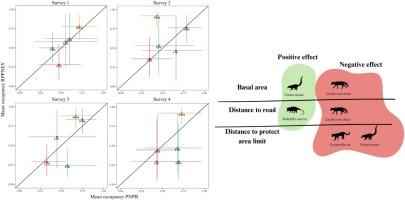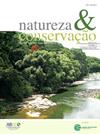中食肉动物占有的异质性凸显了受威胁生态区生物多样性变化的复杂性
IF 3.5
2区 环境科学与生态学
Q1 BIODIVERSITY CONSERVATION
引用次数: 0
摘要
中食性动物对全球环境变化非常敏感,因此是评估人为干扰生态影响的宝贵哨兵物种。在人类改造景观中,了解中食肉动物群落结构和物种栖息地利用对指导保护策略和保护关键生态系统功能和服务具有重要意义。利用摄像机-诱捕器数据,对巴西东北部两个大西洋森林保护区:RPPN esta本文章由计算机程序翻译,如有差异,请以英文原文为准。

Heterogeneity in mesocarnivore occupancy highlights the complexity of biodiversity changes in a threatened ecoregion
Mesocarnivores are sensitive to global environmental changes, thereby serving as valuable sentinel species for assessing the ecological effects of anthropogenic disturbances. In human-modified landscapes, understanding mesocarnivore community structure and species habitat use is useful for guiding conservation strategies and preserving key ecosystem functions and services. Using camera-trap data, we evaluated the occupancy and detection probabilities of mesocarnivore assemblages in two protected areas of the Atlantic Forest, northeastern Brazil: RPPN Estação Veracel (sustainable-use) and Pau Brasil National Park (strictly protected). Ten mesocarnivore species were recorded, with higher species richness and occupancy rates in the strictly protected area. Occupancy and detection probabilities varied substantially among species and over time, with no strong responses to site-scale covariates. Nasua nasua was favored in sites with larger tree basal area, while Cerdocyon thous avoided these sites. Didelphis aurita was more common in sites distant from roads, contrasting with C. thous. All species, particularly Leopardus sp. and N. nasua, tended to use areas near reserve boundaries. Despite the high species diversity, low average occupancy suggests barriers limiting population growth, with some species benefiting from anthropogenic disturbance, underscoring the complexity of mesocarnivore roles in tropical ecosystems.
求助全文
通过发布文献求助,成功后即可免费获取论文全文。
去求助
来源期刊

Perspectives in Ecology and Conservation
Environmental Science-Nature and Landscape Conservation
CiteScore
7.80
自引率
4.30%
发文量
46
审稿时长
59 days
期刊介绍:
Perspectives in Ecology and Conservation (PECON) is a scientific journal devoted to improving theoretical and conceptual aspects of conservation science. It has the main purpose of communicating new research and advances to different actors of society, including researchers, conservationists, practitioners, and policymakers. Perspectives in Ecology and Conservation publishes original papers on biodiversity conservation and restoration, on the main drivers affecting native ecosystems, and on nature’s benefits to people and human wellbeing. This scope includes studies on biodiversity patterns, the effects of habitat loss, fragmentation, biological invasion and climate change on biodiversity, conservation genetics, spatial conservation planning, ecosystem management, ecosystem services, sustainability and resilience of socio-ecological systems, conservation policy, among others.
 求助内容:
求助内容: 应助结果提醒方式:
应助结果提醒方式:


